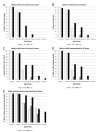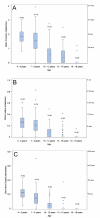The cooperative international neuromuscular research group Duchenne natural history study: glucocorticoid treatment preserves clinically meaningful functional milestones and reduces rate of disease progression as measured by manual muscle testing and other commonly used clinical trial outcome measures
- PMID: 23649481
- PMCID: PMC4103170
- DOI: 10.1002/mus.23808
The cooperative international neuromuscular research group Duchenne natural history study: glucocorticoid treatment preserves clinically meaningful functional milestones and reduces rate of disease progression as measured by manual muscle testing and other commonly used clinical trial outcome measures
Abstract
introduction: Glucocorticoid (GC) therapy in Duchenne muscular dystrophy (DMD) has altered disease progression, necessitating contemporary natural history studies.
Methods: The Cooperative Neuromuscular Research Group (CINRG) DMD Natural History Study (DMD-NHS) enrolled 340 DMD males, ages 2-28 years. A comprehensive battery of measures was obtained.
Results: A novel composite functional "milestone" scale scale showed clinically meaningful mobility and upper limb abilities were significantly preserved in GC-treated adolescents/young adults. Manual muscle test (MMT)-based calculations of global strength showed that those patients <10 years of age treated with steroids declined by 0.4 ± 0.39 MMT unit/year, compared with -0.4 ± 0.39 MMT unit/year in historical steroid-naive subjects. Pulmonary function tests (PFTs) were relatively preserved in steroid-treated adolescents. The linearity and magnitude of decline in measures were affected by maturational changes and functional status.
Conclusions: In DMD, long-term use of GCs showed reduced strength loss and preserved functional capabilities and PFTs compared with previous natural history studies performed prior to the widespread use of GC therapy.
Copyright © 2013 Wiley Periodicals, Inc.
Figures




References
-
- Hoffman EP, Brown RH, Jr, Kunkel LM. Dystrophin: the protein product of the Duchenne muscular dystrophy locus. Cell. 1987;51:919–928. - PubMed
-
- Emery AE. Population frequencies of inherited neuromuscular diseases—a world survey. Neuromuscul Disord. 1991;1:19–29. - PubMed
-
- Haldane JB. Mutation in the sex-linked recessive type of muscular dystrophy; a possible sex difference. Ann Hum Genet. 1956;20:344–347. - PubMed
-
- Bucher K, Ionasescu V, Hanson J. Frequency of new mutants among boys with Duchenne muscular dystrophy. Am J Med Genet. 1980;7:27–34. - PubMed
-
- Caskey CT, Nussbaum RL, Cohan LC, Pollack L. Sporadic occurrence of Duchenne muscular dystrophy: evidence for new mutation. Clin Genet. 1980;18:329–341. - PubMed
Publication types
MeSH terms
Substances
Grants and funding
- UL1RR031988/RR/NCRR NIH HHS/United States
- U54 RR026139/RR/NCRR NIH HHS/United States
- R01 AR062380/AR/NIAMS NIH HHS/United States
- G12RR003051/RR/NCRR NIH HHS/United States
- G12 RR003051/RR/NCRR NIH HHS/United States
- U54RR026139/RR/NCRR NIH HHS/United States
- UL1 TR000448/TR/NCATS NIH HHS/United States
- R01 AR061875/AR/NIAMS NIH HHS/United States
- G12 MD007600/MD/NIMHD NIH HHS/United States
- U54HD053177/HD/NICHD NIH HHS/United States
- R01AR062380/AR/NIAMS NIH HHS/United States
- UL1 RR024992/RR/NCRR NIH HHS/United States
- UL1RR024992/RR/NCRR NIH HHS/United States
- 2U54HD053177/HD/NICHD NIH HHS/United States
- 1R01AR061875/AR/NIAMS NIH HHS/United States
- U54 HD053177/HD/NICHD NIH HHS/United States
- UL1 RR031988/RR/NCRR NIH HHS/United States
LinkOut - more resources
Full Text Sources
Other Literature Sources
Medical
Miscellaneous

